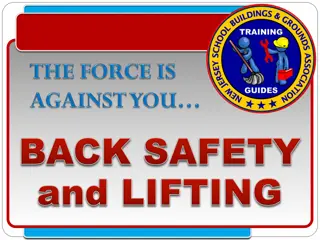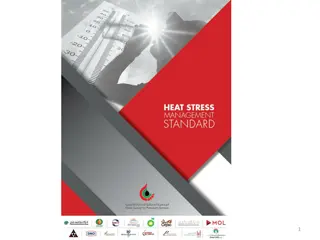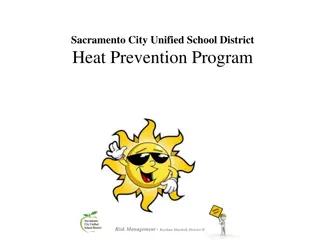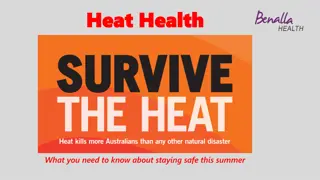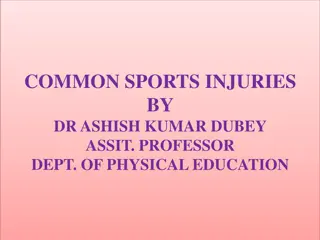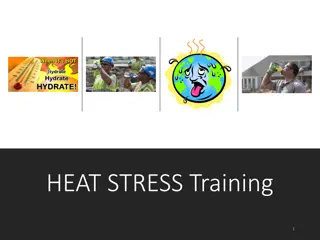Understanding Heat-Related Injuries and Illnesses in the Workplace
Learn about different types of heat injuries/illnesses, prevention tips, statistics, and who is affected by heat-related issues. Discover how heat stress occurs, the body's cooling system, and the dangers of heat stroke. This comprehensive guide will help you understand how to work safely in the sun and protect yourself and others from heat-related risks.
Download Presentation

Please find below an Image/Link to download the presentation.
The content on the website is provided AS IS for your information and personal use only. It may not be sold, licensed, or shared on other websites without obtaining consent from the author. Download presentation by click this link. If you encounter any issues during the download, it is possible that the publisher has removed the file from their server.
E N D
Presentation Transcript
Heat Related Injuries/Illnesses Bureau of Workers Comp PA Training for Health & Safety (PATHS) PPT-045-03 1
Learning Objective To understand how to work safely in the sun PPT-045-03 2
What well Talk About Types of heat injuries/illnesses and who is affected Serious heat related injuries/illnesses Other common heat related injuries/illnesses Dehydration Prevention Tips Who is affected Methods of prevention PPT-045-03 3
Statistics - Average Heat is the #1 weather-related killer in the United States (123); Greater than hurricanes (108), floods (75), and lightning strikes (33). Even more than tornadoes (109). PPT-045-03 4
Generation of Body Heat Metabolic Heat generated through the digestion of food, work, and exercise. Environmental Heat absorbed from the surrounding environment. PPT-045-03 5
The Bodys Cooling System As the body s core temperature rises, several activities increase: Sweating Heart rate Blood flow to the skin When the cooling system works well, the core temperature drops and can stabilize at a safe level. PPT-045-03 6
How does Heat Stress Occur? During warm weather, the body normally cools itself by perspiring. When the air temperature is the same or warmer than the body temperature, cooling the body is more difficult. When the humidity becomes higher, perspiration will not evaporate as quickly, preventing the body from releasing heat as fast as it normally would, causing various levels of heat stress. PPT-045-03 7
Types of Heat Injuries/Illnesses Heat Rash Mild Medical Condition Heat Cramps Heat Syncope Heat Exhaustion Dangerous Medical Emergency Heat Stroke We ll discuss them all during this presentation! PPT-045-03 8
Who is Affected? Workers Co workers Elderly Children Pets Friends Neighbors Everybody PPT-045-03 9
When Working in Sunlight is Necessary Limit outdoor work in high temps Avoid working in direct sunlight between 10 am 4 pm Rest in the shade Use a hat with a brim Use suntan lotion SPF 30 or higher Use eye protection Drink plenty of water PPT-045-03 10
Prevention of Heat Related Injuries/Illnesses PPT-045-03 11
So What do You Do? OSHA recommends three simple words: PPT-045-03 12
Three Simple Words WATER drink water (or electrolyte beverages) often, even before you become thirsty REST take frequent breaks away from the sun s rays; recommended air-conditioned or cool, well- ventilated area SHADE anywhere people can take shelter from the sun (tree, canopy, indoors); recovery area PPT-045-03 13
Prevention Drink plenty of fluids If you re thirsty: it s too late No caffeine No alcohol No large amounts of sugar Avoid very cold drinks PPT-045-03 14
Ability to Cool Down: Factors Acclimation Physical condition Environment High heat Humidity Proper hydration Asset management PPT-045-03 15
Heat Index Protective Measures Heat Index Risk Level Lower (Caution) Basic heat safety and planning Less than 91 F Implement precautions and heighten awareness Moderate 91 F to 103 F Additional precautions to protect workers High 103 F to 115 F Triggers even more aggressive protective measures Very High to Extreme Greater than 115 F The heat index is based on being in the shade Work considerations Heavy work gear Work in direct sunlight Degrees to add Add 10 Add 15 PPT-045-03 16
Serious Heat Related Conditions Heat Exhaustion PPT-045-03 17
Heat Exhaustion Heat exhaustion is the body's response to an excessive loss of the water and salt, usually through excessive sweating. Workers most prone to heat exhaustion are those that are elderly, have high blood pressure, and those working in a hot environment. http://ts1.mm.bing.net/th?id=H.4709308155887632pid=15.1 PPT-045-03 18
Heat Exhaustion Signs & Symptoms Weakness Heavy sweating Extreme weakness or fatigue Dizziness, confusion Nausea Clammy, moist skin Pale or flushed complexion Muscle cramps Slightly elevated body temperature Fast and shallow breathing Heat Exhaustion is considered a Medical Emergency! PPT-045-03 19
Heat Exhaustion Treatment Call 911 and notify their supervisor. Have them rest in a cool, shaded or air-conditioned area. Have them drink plenty of water or other cool, nonalcoholic beverages. Have them take a cool shower, bath, or sponge bath. PPT-045-03 20
Serious Heat Related Conditions Heat Stroke PPT-045-03 21
Heat Stroke o Is the most serious heat-related disorder. o Occurs when the body becomes unable to control its temperature. o Body's temperature rises rapidly, sweating mechanism fails, body is unable to cool down. o When heat stroke occurs, body temperature can rise to 106 degrees Fahrenheit or higher within 10 to 15 minutes. o Heat stroke can cause death or permanent disability if emergency treatment not given. PPT-045-03 22
Heat Stroke Signs & Symptoms Hot, dry skin or profuse sweating Hallucinations Chills Throbbing headache High body temperature Confusion/dizziness Slurred speech PPT-045-03 23
Heat Stroke Treatment Call 911 and notify their supervisor. Move the sick worker to a cool shaded area. Cool the worker using methods such as: Soaking their clothes with water. Spraying, sponging, or showering them with water. Fanning their body. PPT-045-03 24
Heat Stroke Summary This is a medical emergency Never allow the person to return to work or go home without medical attention & clearance Return to work will vary depending on individual s physical fitness & timing of first aid treatment PPT-045-03 25
Other Common Heat Related Injuries/Illnesses PPT-045-03 26
Heat Syncope Symptoms: - Fainting - Dizzy - Light Headed Treatment: - Sit or lie down in cool place when they begin to feel symptoms. - Slowly drink water, clear juice, or a sports beverage. PPT-045-03 27
Heat Cramps Symptoms - Muscle pain or spasms usually in the abdomen, arms, or legs. First Aid - Stop all activity, and sit in a cool place. - Drink water, clear juice or a sports beverage. - Do not return to strenuous work for a few hours after the cramps subside because further exertion may lead to heat exhaustion or heat stroke. - Seek medical attention if any of the following apply: The worker has heart problems. The worker is on a low-sodium diet. The cramps do not subside within one hour. PPT-045-03 28
Heat Rash Symptoms: - Red cluster of pimples or small blister - Can happen anywhere on body Neck Back Groin First Aid: - Work in a cooler area if possible - Keep area dry - Powders may be used for comfort PPT-045-03 29
Effects of Sunburn Sunburn is the sun s ultraviolet radiation, which can significantly retard the skin s ability to shed excess heat. Must apply sunscreen (SPF 30 or higher) to avoid redness and pain. Severe cases could be swelling of skin, blisters, fever, and headaches. Ointments may be used for blisters, sterile dressing if blisters break. If serious, seek medical attention. PPT-045-03 30
Controlling Heat Stress PPT-045-03 31
Training How to control heat stress. How to recognize, treat, and prevent heat illness. The role of weather, workload, PPE, and the individual s physical condition. PPT-045-03 32
Workload Workload determines the amount of heat generated by the body Light and moderate work = less heat Heavy work = more heat PPT-045-03 33
Clothing The more clothing worn, the longer it takes evaporation to cool the skin. Lightweight, light-colored clothing reflects heat and sunlight and helps your body maintain normal temperatures. Wear loose-fitting clothes such as cotton. Wide brimmed hats block sun from head, neck and shoulders. PPT-045-03 34
PPE Selection Use lightest weight garments and respirators available. If cooling vests are used, they must be selected carefully and washed daily. Coated and non-woven personal protective garments block evaporation of sweat. PPT-045-03 35
Employees Responsibilities Follow instructions and training for controlling heat stress. Pay attention to symptoms of self and others. Avoid dehydration by drinking plenty of water. Get adequate rest and sleep. Avoid alcohol, drugs, and excessive caffeine. PPT-045-03 36
Dehydration Fluid loss of 2% - Impaired cognitive and physical performance Fluid loss of 5-7% - Shortness of breath, headaches, dizziness and apathy PPT-045-03 37
Simple Hydration Check Good, probably well hydrated; drink water normally OK/fine; drink a little water now Warning: Drink about bottle of water within the hour, or whole btl if you're outside and/or sweating Caution: Drink about bottle of water immediately or drink a whole bottle of water if you're outside & sweating STOP: Drink 2 bottles of water immediately; if your urine is darker than this red or brown, there may be another medical condition, seek medical advice PPT-045-03 38
Use Caution NEVER take a nap/rest in a closed, parked vehicle. - Especially if you have certain medical conditions such as diabetes or high blood pressure. - If you are feeling ill. - Unless air conditioning is on and functioning properly. PPT-045-03 39
Vehicle Heating Dynamics The sun s radiation can heat a dashboard, steering wheel, or child seat up to 180-200 degrees Fahrenheit. It also warms the air trapped inside the vehicle: - In 10 minutes: Outside 80, inside 99 degrees - In 20 minutes: Outside 80, inside 109 degrees - In 30 minutes: Outside 80, inside 114 degrees - In 60 minutes: Outside 80, inside 123 degrees PPT-045-03 40
Tips for Prevention Stay indoors and utilize AC Fans Cool shower Wear lightweight, light colored & loose fitting clothes. Limit your outdoor activity to morning and evening hours. Protect yourself from the sun by wearing a wide-brimmed hat, sunglasses and by putting on sunscreen of SPF 30 or higher. Drink more fluids (nonalcoholic) PPT-045-03 41
Review Slow down Dress for activity Watch what you eat Drink plenty of fluids Spend more time in AC Don t get too much sun Consult with doctor if any medical questions PPT-045-03 42
Review Heat Stroke & Heat Exhaustion - Most dangerous-seek medical attention - Watch for signs & symptoms Heat Syncope - Can lead to Heat stroke or exhaustion-Monitor - Remove from heavy workload Heat Cramps - Increase fluids, be aware of other conditions Heat Rash - Wearing lightweight clothing made of fabrics that "breathe" and limiting physical activity PPT-045-03 43
OSHA Heat Safety Tool app http://www.osha.gov/SLTC/heatillness/heat_inde x/heat_app.html PPT-045-03 44
Contact Information Health & Safety Training Specialists 1171 South Cameron Street, Room 324 Harrisburg, PA 17104-2501 (717) 772-1635 RA-LI-BWC-PATHS@pa.gov Like us on Facebook! - https://www.facebook.com/BWCPATHS PPT-045-03 45
Questions Questions PPT-045-03 46
















